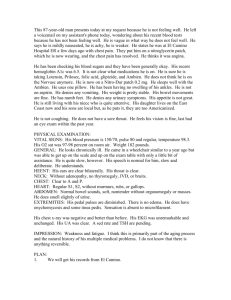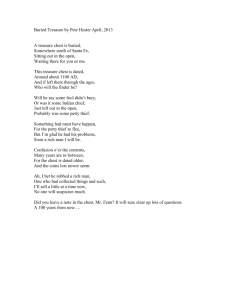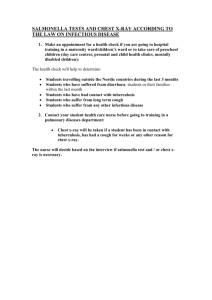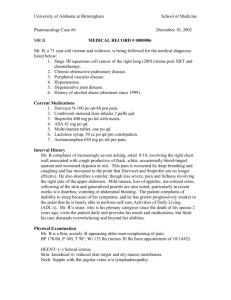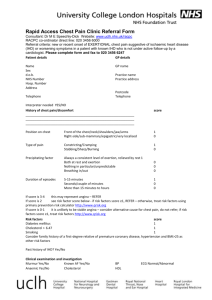Facilitators handbook for workshop
advertisement
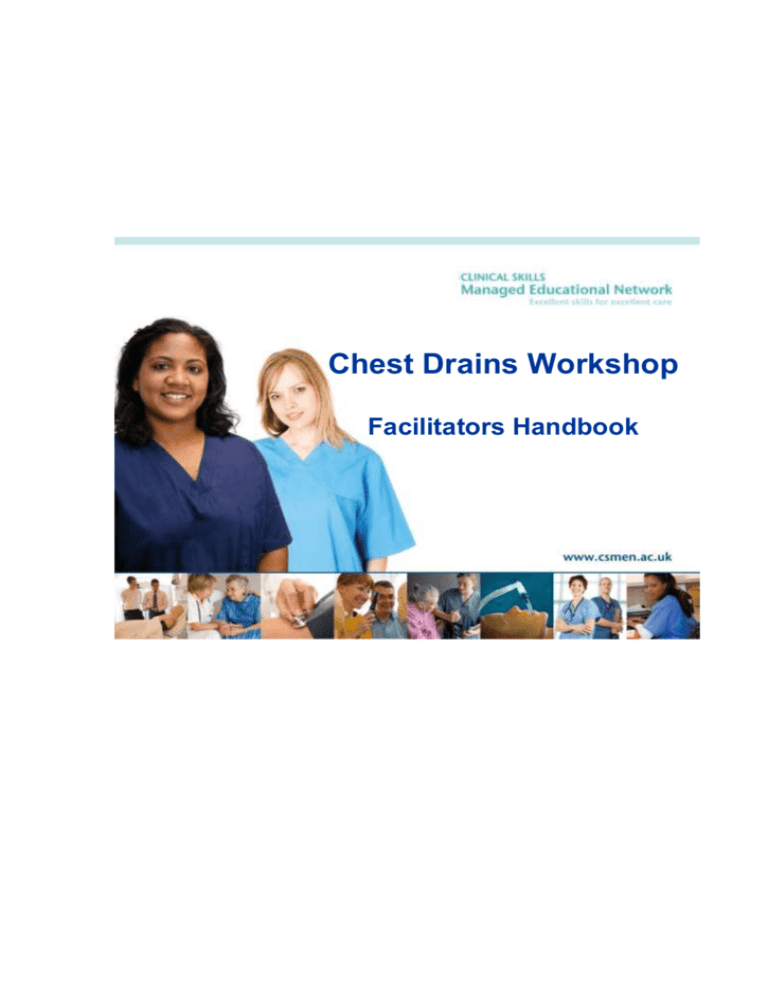
Chest Drains Workshop Facilitators Handbook Chest Drains [insert date] [insert time] [insert venue] 1. Introductions 15 mins 2. Overview of workshop 20 mins o Timetable o Learning outcomes o Key content 3. Small Group activities 45 mins per activity 4. Feedback from small groups 30 mins 5. Completion of learning sheet profile & evaluation 20 mins Names of facilitators: [……..] Maximum no. of participants: [……] To book a place, email the following: [………..] Introduction This workshop has been developed to support practitioners in the use and management of chest drains. The workshop is interactive involving the use of role play and is set up to enhance competencies within the chest drain context. Participants It is expected that participants in the workshop will have some theoretical knowledge of chest drains and it is recommended that they have completed the CS MEN Chest Drain Educational Skills Pack (http://www.sharedlearning.scot.nhs.uk/). Number of participants: minimum 6 -maximum 10 Pre - workshop Each participant should be familiar with the theory of insertion, management and removal of chest drains prior to attending the workshop. All participants will be expected to share their own learning needs at the start of workshop. Instructions for Facilitators There is an outline of the timings and suggested structure for the workshop to ensure all outcomes are met. There is also an accompanying power point to use at the start of the workshop. A suggested format for running the scenarios is given below. It is also essential that ground rules are agreed at the beginning of the workshop. You should aim to undertake two to three scenarios during the course of the workshop. This will depend on the number of participants and the additional learning outcomes identified at the start of the workshop. If the video and debriefing equipment is to be used please ensure participants have given signed agreement to be videoed during the simulation. It is also essential to obtain feedback from participants at the end and a generic evaluation form is included in the pack. It is your role to create a safe environment for the participants so that they want to learn from analysing their own deliberate practice. 1. Introductions You may wish to add you own powerpoint slides to those already included. Please make sure everyone has name badges and has an opportunity to introduce themselves and share their current role. 2. Overview of workshop You should state how long you expect the workshop to last, if and how you will be breaking into small groups and that you will come together towards the end for a feedback/debrief session. If you are using the video equipment you should explain about its use. The aim and outcomes for this workshop are linked to the outcomes for the CS MEN Chest Drain pack. Aim On completion of the chest drain programme (completion of the pack, attendance at simulated practice session, supervised practice and successful completion of assessments) the practitioner will be competent in the clinical skill of the insertion of or removal of a chest drain and the management of a patient with a chest drain in place. Outcomes At the completion of this workshop participants will be able to: Demonstrate clinical competence in the simulated procedure of chest drain insertion Demonstrate clinical competence in the simulated management of chest drains Demonstrate clinical competence in the simulated removal of chest drains Engage in evaluation and critical analysis post procedure Verification of learning outcomes and PEPs As each person introduces themselves please explore any other learning needs they have in addition to those above. It is often useful to note these down and return to them at the end of the session Share and agree ground rules Each session should have agreed ground rules ie. It should be agreed with participants what areas of performance will be discussed at feedback before the session begins Feedback should be specific and focus on what was observed Everyone in the group should be a participant in the feedback Key content This workshop has a selection of four different scenarios covering the use, management and removal of the main types of chest drains. You may choose to use some or all of these scenarios. The scenarios included in this facilitators pack also have the suggested answers (in orange, two per scenario) so please ensure they are removed prior to use by participants or use the power point slides for print outs. 3. Small group activities To ensure that each scenario/activity runs to time and to enhance learning it is suggested the facilitator takes the following steps 1. Outline the context of the scenario 2. Provide participants with their roles (if appropriate) 3. Reiterate ground rules 4. Agree preparation time 5. Agree issues/outcomes which will be discussed in the debrief 6. Gain written permission to video (if using) 7. Run the scenario 8. Debrief 9. Agree learning points for participants and for clinical practice The scenarios/activities can be structured with varying degrees of complexity and difficulty. This will depend on the level of experience of the participants and their current roles in their health care teams. 4. Feedback from small groups Hints on debriefing In the debriefing process it can be useful to follow a structured approach following an advocacy and inquiry approach (Schon 1987). If you have agreed outcomes then use the following structure: - Ask the participant to describe what happened - Ask the participant how they felt during the simulation event - Use specific examples to inquire /seek clarification about what was happening and why it was happening from participant perspective - Explore with participants and other observers alternative approaches - Agree action plan Four skills you can use during debriefing are - Prevent common criticisms by addressing these at start of debrief i.e. regarding realism - Give participant a breather – ask others to contribute - Validate feelings - Normalisation – group can share similar experience 5. Completion of Personal Education Plan (PEP) & evaluation This is an opportunity to discuss the learning points from the scenarios and to think in small groups how these could be implemented or incorporated in the context of their local health care team. Each participant should leave with an action plan in relation to their own PEP in light of their experience. It is important in facilitating this transfer to practice to realise that each participant ‘s action plan will be different. They should have an Action plan for Improvements/ changes they will make to their own practice tomorrow Points to improve/clarify around their local PEP Please ensure time is left for each participant to complete the evaluation form Scenario One A 36 year old male is involved in an RTA. He was the driver of a car going around 60mph that drove head on into a van travelling at similar speed. After extrication from the car (with full spinal immobilisation) the patient is transferred to the local ED. On arrival in the ED: A- Airway patent, talking in sentences B- crepitus and tenderness L lateral ribs, decreased air entry L chest, sats 95% on 15L O2, RR 25 per minute C- Cool peripheries, P 120bpm, BP 90/40 mmHg, Abdomen soft and non-tender D- Alert, BM 5.0 E- Deformity mid L thigh and R wrist A portable chest x-ray is rapidly performed in the resus room 1.1 What does the x-ray show? Answer: Traumatic L haemothorax 1.2 What action will you take? Answer: Insertion of large bore chest drain Scenario Two A 24 year old male is admitted to the medical assessment unit, complaining of sharp chest pain that came on suddenly that morning. Observations are pulse 100 bpm, respiratory rate 25, BP 120/70mmHg, O2 saturations on air 94%, temp 36.5 Chest examination reveals decreased breath sounds to the left side of the chest 2.1. What investigations will you get? Answer: ECG, CXR, if normal CXR then consider D-dimer and ABG 2.2 What drainage option will you choose for this? Answer: Small bore seldinger chest drain Scenario Three You are a paramedic in Wigtown (D&G) when you are called to a local pub in which a young man has allegedly been stabbed. On arrival the patient is lying in a pool of several litres of blood and is clearly shocked and unconscious. A- patent B- respiratory distress, RR 40 (shallow), stab wound to R ant lower chest, trachea deviated to L, absent BS R chest C-weak thready pulse rate approximately 140 bpm 3.1 What is your initial management? Answer: High concentration O2, needle decompress R chest 54 miles to nearest ED!! 3.2 Is additional pre-hospital intervention necessary for this patient? Answer: Balanced decision, large bore pre-hospital drain v scoop and run Scenario Four An 85-year old male was admitted 2 days ago to the respiratory ward because of a right sided pleural effusion. A small bore chest drain was inserted at this stage. The student nurse has informed you that the patient is complaining of sudden onset of pain in his right chest and breathlessness. 4.1. What do you do? Answer: Check –patient, drain, tubing, bottle, wound, height Patient in respiratory distress Drain not swinging 4.2 What do you do? Answer: GET HELP Chest Drains Workshop Before you leave today we would be grateful if you would take the time to complete this evaluation form. This will help us to improve our services to you and ensure that future programmes for the mobile unit meet your needs. Session attended: [insert date/title] am Date: _______________________________ pm all day Overall Rating 1. Overall rating of the experience Excellent Good Satisfactory Poor Very Poor Quality of Workshop Organisation and Venue Excellent Good Satisfactory Poor Very Poor 2. Pre-workshop organisation 3. Organisation of the morning 4. Refreshments 5. Meeting room facilities 6. Presentations & demonstrations Your Expectations and Realisations 7. 8. What was your main goal for the workshop? In general, did the workshop accomplish this? What were the most interesting or useful aspects of the workshop? 9. What were the least useful aspects or those that need most improvement? 10. Circle the words which best describe the workshop. Use as many descriptors as you wish or feel free to add in others: boring practical instructive Quality of Event Organisation and Venue Enjoyable relevant threatening tedious valuable stimulating challenging worthwhile dull theoretical uninteresting pointless interesting predictable Future Events 11. Do you have any suggestions for workshops or events that you would like the Clinical Skills Managed Educational Network to organise? Contact Information (Optional) Name: …………………………………………………………………………………………………………………………………………… Job title: …………………………………………………………………………………………………………………………………………… Place of work and email address: …………………………………………………………………………………………………………………………………………… Certificate of Completion Chest Drain Workshop: This is to certify that Name: _____________________________________ Role: _____________________________________ completed the above Workshop on [insert date] at [insert venue] Signed on behalf of the Clinical Skills Managed Educational Network: ……………………………………....................... Dr Jean Ker (Clinical Lead, CS MEN) ……………….. Date



